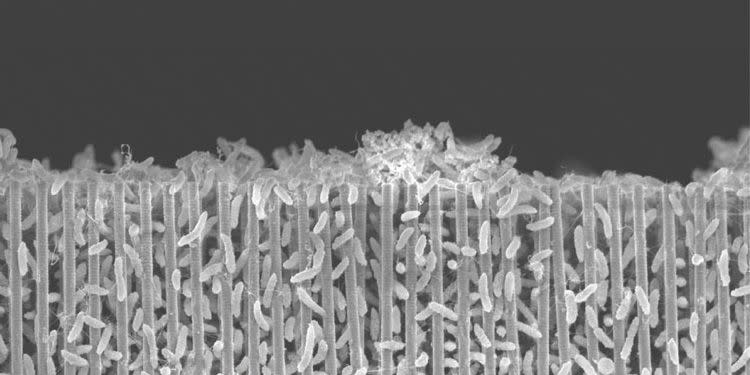When We Settle on Mars, Here's How We'll Build Life from the Ground Up

A biohybrid scaffold of bacteria and nanowires could reduce carbon dioxide and help us live on Mars.
Payload logistics are key to any space travel, and self-replicating organisms are immensely valuable.
These bacteria convert carbon dioxide and water into life-building acetate molecules.
Scientists from the University of California, Berkeley have built a nano-sized power plant, emphasis on “plant”: their device uses sunlight to convert carbon dioxide and water into new organic molecules.
The device is an assemblage of bacteria attached to a scaffold of nanowires. Researchers say it could be key to enabling the manufacture of a variety of vital ingredients for drugs and more for future Mars settlers.
Very little of Earth’s atmosphere is carbon dioxide—and here, it takes very little difference to disrupt life and the ecosystem. But the atmosphere of Mars is almost inverted, with 96 percent carbon dioxide instead of the about 1 percent on Earth. Capitalizing on the most plentiful atmospheric gas is just good math in terms of building a plausible way to live on Mars.
On Earth, plants live on sunlight, but do it inefficiently. The most efficient plant on Earth, the researchers say, is sugar cane, which can convert up to 5 percent of sunlight and carbon dioxide into sugar. The structure of the nano power plant is a two-part system that mimics how mechanisms function for real plants. A frame made of nanowires draws in electrons that serve as food for the vital bacteria attached to the frame, and these bacteria convert the electrons into acetate molecules.
Acetate is the common term for a kind of consumer plastic, but that’s only the tiniest tip of the acetate iceberg. In its simplest chemical form, acetate, or acetic acid, is vinegar. Acetate molecules are key to building many of the components of life through biosynthesis. Molecules in the body, like amino acids and cholesterols, are biosynthesized.
“Acetate molecules can serve as building blocks for a range of organic molecules, from fuels and plastics to drugs,” the Cal scientists said in a statement. “Many other organic products could be made from acetate inside genetically engineered organisms, such as bacteria or yeast.”
Chemistry professor and project lead Peidong Yang says the group is working on similar systems that could produce “sugar and carbohydrates”—again a souped-up biohybrid based on how plants operate.
The idea of living on Mars is still pretty far out in terms of feasibility, but the Cal team hopes this bacterial nanoscaffold could have applications for reducing pollution on Earth. On Mars, carbon dioxide is the only logical choice for a naturally abundant fuel source. On Earth, grabbing carbon dioxide from the air and turning it into energy could end up making a difference in environmental outcomes. That’s still a faraway goal, too, but one that’s a little more down to Earth.
And in the long term, this NASA-sponsored research could indeed make a big difference. “For a deep space mission, you care about the payload weight,” Yang said. “[B]iological systems have the advantage that they self-reproduce: You don’t need to send a lot. That’s why our biohybrid version is highly attractive.”
You Might Also Like

